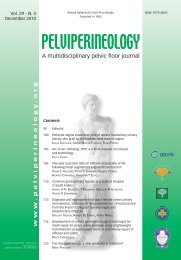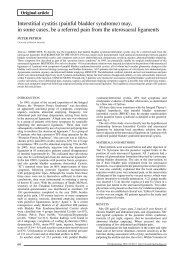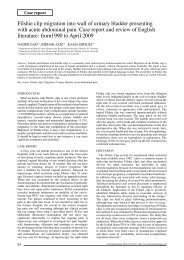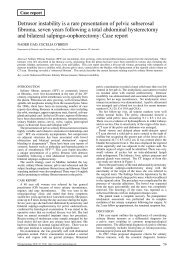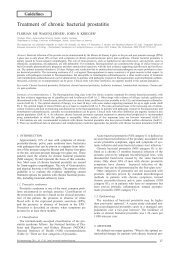Bilateral iliococcygeus fixation technicque for ... - Pelviperineology
Bilateral iliococcygeus fixation technicque for ... - Pelviperineology
Bilateral iliococcygeus fixation technicque for ... - Pelviperineology
Create successful ePaper yourself
Turn your PDF publications into a flip-book with our unique Google optimized e-Paper software.
<strong>Bilateral</strong> ileococcygeus <strong>fixation</strong><br />
Table 4 - Surgery data.<br />
<br />
Variables<br />
Estimated blood<br />
<br />
Intraoperative<br />
complication<br />
Postoperative<br />
complication<br />
<br />
All patients<br />
<br />
None<br />
No. patients/mean±SD<br />
Blood transfusion <strong>for</strong> symptomatic<br />
anemia - 1 patient<br />
Left leg pain * - 1 patient<br />
Low urinary tract infection - 1 patient<br />
<br />
<br />
*<br />
Resolved after 3 months<br />
**<br />
One patient after TVT, all resolved in less than 2 months<br />
Table 5 - Analysis of patients with postoperative prolapse greater<br />
than grade 1.<br />
No.<br />
pts.<br />
Postop. site<br />
and grade of<br />
prolapse<br />
Preop. site<br />
and grade of<br />
prolapse<br />
Use<br />
of<br />
Mesh<br />
Previous<br />
prolapse<br />
surgery<br />
1 R2 Yes R2 Yes Yes Yes<br />
2 R3 No R1 No No No<br />
3 R3,E2,VP3 Yes R2,E2,VP1 No No No<br />
4 R2,E2,VP2 Yes R3,E2 Yes No No<br />
E2,VP2 No E2 Yes No Yes<br />
R2 N0 R2 No No No<br />
7 R2 Yes R2 Yes Yes Yes<br />
CU2 Yes CU0 No No No<br />
CU2 No CU1 No No No<br />
CU= cystoureterocele, R= rectocele,<br />
E= enterocele, VP= vault prolapse<br />
Table 6 - Comparison between patients with poor and successful<br />
surgical results.<br />
Variable<br />
<br />
<br />
<br />
Successful group<br />
(n=20)<br />
Failed group<br />
(N=9)<br />
P value*<br />
NS<br />
<br />
<br />
<br />
<br />
NS<br />
NS<br />
<br />
largest child<br />
<br />
<br />
<br />
<br />
<br />
NS<br />
2 NS<br />
Previous<br />
hysterectomy<br />
Previous prolapse<br />
surgery<br />
NS<br />
NS<br />
Symptoms<br />
Operation<br />
<strong>for</strong> this<br />
compartment<br />
cement<br />
therapy, hospitalization time, estimated blood loss during<br />
surgery and intra- and postoperative complications.<br />
* Chi-square test<br />
** BMI- body mass index<br />
<br />
3 of them were symptomatic. The mean time to recurrent<br />
<br />
Analysis of patients with postoperative prolapse greater<br />
<br />
<br />
<br />
1.0 cm<br />
<br />
difference in vaginal hiatus width or perineal body lengths.<br />
<br />
She was not sexually active and had had a previous vaginal<br />
hysterectomy combined with cystocele and rectocele repair.<br />
DISCUSSION<br />
Surgery <strong>for</strong> vaginal vault prolapse has several goals:<br />
restore the normal anatomy, relieve symptoms, restore<br />
normal bowel and bladder function, and preserve satisfactory<br />
sexual function. Vaginal vault prolapse and enterocele may<br />
be a source of frustration to the surgeon because of the<br />
<br />
term, especially when preservation of a functional vaginal<br />
length is necessary. Benson et al noted that 33% of patients<br />
who had previous vaginal surgery <strong>for</strong> prolapse required reoperation<br />
<strong>for</strong> recurrence. A variety of abdominal and vaginal<br />
surgical techniques have been suggested to correct the pelvic<br />
<br />
<br />
pelvic surgery, the quality of the pelvic support tissues and<br />
<br />
approaches <strong>for</strong> vault prolapse repair are sacrospinous<br />
<br />
<br />
include damage to the neurovascular bundle that runs in<br />
<br />
in vaginal deviation laterally and exposes the anterior<br />
vaginal wall to persistent or subsequent cystocele in up to<br />
37% of the patients. The main problematic complication<br />
of uterosacral suspension is ureteral obstruction reported<br />
in up to 11% of the patients . Other disadvantages of<br />
both procedures are the need <strong>for</strong> a certain vaginal length<br />
and mobility in order to bring the vaginal vault to the<br />
sacrospinous or uterosacral ligaments without tension, and<br />
the need <strong>for</strong> a wide dissection to visualize the sacrospinous<br />
ligaments. Such dissection may increase the risk of bleeding<br />
By contrast, the <strong>iliococcygeus</strong><br />
fascia does not have critical structures such as the pudendal<br />
<br />
There<strong>for</strong>e, it is theoretically associated with a lowers rate of<br />
pelvic pain from nerve entrapment, bleeding, and ureteral<br />
<br />
<strong>iliococcygeus</strong> fascia in relation to the other anchoring pelvic<br />
<br />
<br />
<br />
anatomic position of the upper vagina. Another advantage<br />
<br />
mobility or a short vagina that cannot be attached to the<br />
sacrospinous or the uterosacral ligaments without tension.<br />
<br />
previous surgery <strong>for</strong> prolapse. Yet, in none of them did we<br />
<br />
fascia or accomplished the sutures placement. Patients<br />
weight, vaginal length, and previous pelvic surgery had<br />
no effect on the feasibility of the procedure. There were<br />
no intraoperative complications and the postoperative<br />
complications were left leg pain in one patient, which we<br />
attributed to surgical positioning resolved spontaneously<br />
13



